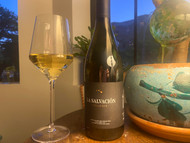Godello? ¿Qué es eso?
Posted by Connor Kennedy on May 18 2022 12:53pm
This week brings us to the tiny wine region of Bierzo, which sits in the northwestern part of Spain as part of the grander region of Castilla y Léon. Having been granted Denominación de Origen (D.O.) status in 1989, the wines from this region have since grown in popularity and international consumption, and for good reason. The aromatic red grape Mencía dominates, having become nearly synonymous with Bierzo, but the oft overlooked whites deserve careful attention too. This includes the obscure white grape Godello, beautifully exhibited by this 2018 “La Salvación” by César Márquez Pérez. Picked from 100 year-old vines, these thick-skinned grapes brought us a deep and concentrated wine, defined by its vibrant and distinct minerality.
Pérez’s family has owned the Castro Ventosa winery in Bierzo since 1752, so he and his family know the land like the back of their own hands. César Márquez had a wealth of knowledge to pull from his own family, including from his uncle, Raúl Pérez, who runs Castro Ventosa. He branched out and started his own solo project in 2015, making wines with Mencía, Alicante Bouschet, and Godello, among others. He is modeling his bottlings after the appellation system in Burgundy, drawing distinctions between single vineyards and village wines. Though this is an ambitious endeavor, he is determined to show that the varietals grown in Bierzo have a capacity to convey the remarkable nuances of their respective terroirs. The region’s unique soil composition, which is composed of significant amounts of granite and slate, coupled with its unique climate and terraced vineyards, means this endeavor is one worthy of our respect.
César Márquez Pérez with some vines.
And what better way is there to convey that respect than to drink and share the wine? I’ll admit, Spanish wine has long been one of my blinds spots, so when I drink it my first instinct is to compare it to wines and regions I am more familiar with. From the nose, I was immediately reminded of a Chablis - there was a striking minerality along with ripe pear and other orchard fruit notes. The palate largely concurs, but with a rounded-out and fleshy texture that showed just how concentrated the flavors of the wine was. The acidity plays well with this texture, carrying itself cleanly through the finish. The more I took in the nose of the wine, the more distinctive its minerality became. There was something specifically dark and savory about it, both on the nose and on the palate, that was quite different from any Chablis I’ve had. Perhaps that arose from the soil composition, or the short time Pérez matured the wine under flor, a yeast that sits on the surface of a wine in a barrel.
In the end, I thought of the wine not as “like a Chablis”, but merely a delicious Godello from Bierzo. Comparisons are useful, especially when drinking one of the thousands of grape varietals that grow on vines today, but it’s just as important to parse their differences. Perhaps the next time I drink a glass of a flinty Chablis from Burgundy, I will think to myself that it reminds me of a Godello from Bierzo.

